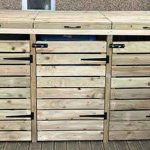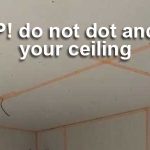Dot and dab is a popular way of installing plasterboards on solid surfaces. Boards are fixed to the wall via dabs of drywall adhesive. This adhesive sets hard and provides a solid flat surface that can be finished with skimmed plaster.
Dot and dab is not that difficult, and with a little practice, even a DIY novice would be able to fit a few boards with this method.
Below you can see the cost of dot and dab per m2. This shows the cost of a DIY project (materials only), as well as the cost to hire a professional.

Materials only – A standard bag of drywall adhesive, will cost roughly £13; this will usually cover around 4-5m2. Therefore, the cost per 1m2 would be between £2.60 – £3.25, or £2.93 on average.
A standard 2400 x 1200mm square edged plasterboard, costs approximately £11. This means the cost per 1m2 is £3.93.
The total cost for materials would be roughly £6.86/m2
Materials + Labour – If you are hiring a professional, you need to consider the cost of labour as well as materials.
The average cost for a plasterer on a day rate is roughly £170. Obviously, this could range considerably based on your location in the country.
In a day, the average plasterer could dot and dab roughly 50m2. This is assuming they are working alone and at a normal pace. Therefore, the average cost per m2 would be roughly £3.40.
So, the total cost for material and labour to dot and dab, would be approximately £10.26 per m2. This is roughly 2/3 materials and 1/3 labour.
Obviously these numbers are just averages. You can see several reasons this number could vary below.
Things that can affect the price of dot and dab per m2
Materials
The price for materials shown above, should be quite consistent. Obviously, you can shop around for the best prices on your adhesive and plasterboards. However, these prices will be in the standard range.
Things that could affect the materials price, other than costs between suppliers, would include:
- Plasterboard size – Smaller boards will be more expensive per m2
- Plasterboard thickness – Obviously 15mm boards will be more expensive than 9mm boards.
- The type of plasterboard – Above we priced for standard square edge. Other options could include, tapered edge, moisture resistant, fire resistant, insulated plasterboard, etc.
With that said, for a standard dot and dab job, the prices mentioned above should be pretty close.
One final thing that could affect the materials price, is if the plasterer supplies materials. In this case, it is quite common for a trades-person to add a percentage for their time spent on collection and transport. This could be anywhere from 10-30%.
However, most trades will get a discount from there usual supplier. This means, the markup will often not affect the price the consumer pays, and they could end up paying similar to the retail prices anyway.
Labour
There are a lot of things that could affect labour prices. Generally, prices per m2 will work better on larger commercial projects, where a plasterer will have a clear run at a large amount of work. This could include things like corridors or large open office spaces.
In a domestic setting such as a house, this is less common. For example, they may be doing other work in between, such as boarding ceilings and skimming other rooms.
There is also the hassle of access in a residential property. Boarding will be in multiple rooms, there are obstacles to contend with, such as furniture. Plus, there is likely to be more cuts due to corners, windows, doors etc.
All these things could result in a lower number of boards fitted in a day. Obviously this will push up the average cost per m2.
Another thing that could affect price, is whether the plasterer has a labourer. If they do, you may find the labourer does dot and dab whilst the plasterer concentrates on skimming the walls.
This could work out cheaper if the labourer has a lower day rate. However, this will depend on a case-by-case basis.
The final thing that can affect price is prep work. Not every surface is ready for dot and dab. The surface needs to be clean, free from dust and dirt and in good condition. It also needs to provide a good key for the adhesive dabs, otherwise the boards could literally fall off.
The prep work that is required, will vary considerably based on the surface where boards are being installed.
Conclusion
As you can see, for dot and dab, the average cost of materials is roughly £6.86 per m2. The cost for labour is generally going to be around £3.40. Therefore, you should expect to pay a little over £10m2.
However, this is not set in stone. Prices for materials can vary by supplier and the cost of labour can be affected by a wide variety of circumstances.
It is more common for plasterers to do this sort of work on a day rate. Regardless of how they price, materials should be fairly similar. Therefore, if labour cost between 30-40% of the total price for dot and dab, you are getting a good deal.




